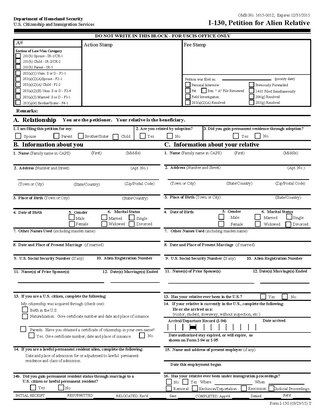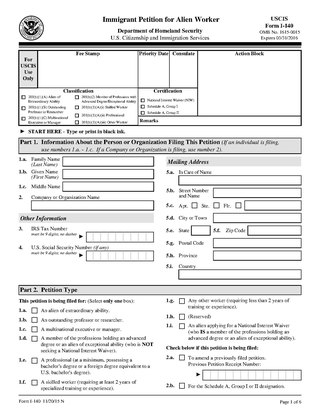
A green card, known officially as a permanent resident card, is an identity document which shows that a person has permanent residency in the United States. Green card holders are formally known as lawful permanent residents (LPRs). As of 2019, there are an estimated 13.9 million green card holders, of whom 9.1 million are eligible to become United States citizens. Approximately 18,700 of them serve in the U.S. Armed Forces.
The H-1B is a visa in the United States under the Immigration and Nationality Act, section 101(a)(15)(H), that allows U.S. employers to employ foreign workers in specialty occupations. A specialty occupation requires the application of specialized knowledge and a bachelor's degree or the equivalent of work experience. The duration of stay is three years, extendable to six years, after which the visa holder can reapply. Laws limit the number of H-1B visas that are issued each year. There exist congressionally mandated caps limiting the number of H-1B visas that can be issued each fiscal year, which is 65,000 visas, and an additional 20,000 set aside for those graduating with master’s degrees or higher from a U.S. college or university. An employer must sponsor individuals for the visa. USCIS estimates there are 583,420 foreign nationals on H-1B visas as of September 30, 2019. The number of issued H-1B visas have quadrupled since the first year these visas were issued in 1991. There were 206,002 initial and continuing H-1B visas issued in 2022.
An L-1 visa is a visa document used to enter the United States for the purpose of work in L-1 status. It is a non-immigrant visa, and is valid for a relatively short amount of time, from three months to five years, based on a reciprocity schedule. With extensions, the maximum stay is seven years.
An O visa is a classification of non-immigrant temporary worker visa granted by the United States to an alien "who possesses extraordinary ability in the sciences, arts, education, business, or athletics, or who has a demonstrated record of extraordinary achievement in the motion picture or television industry and has been recognized nationally or internationally for those achievements", and to certain assistants and immediate family members of such aliens.
A K-1 visa is a visa issued to the fiancé or fiancée of a United States citizen to enter the United States. A K-1 visa requires a foreigner to marry his or her U.S. citizen petitioner within 90 days of entry, or depart the United States. Once the couple marries, the foreign citizen can adjust status to become a lawful permanent resident of the United States. Although a K-1 visa is legally classified as a non-immigrant visa, it usually leads to important immigration benefits and is therefore often processed by the Immigrant Visa section of United States embassies and consulates worldwide.
TN status is a special non-immigrant classification of foreign nationals in the United States, which offers expedited work authorization to a citizen of Canada or a national of Mexico. It was created as a result of provisions of the North American Free Trade Agreement that mandated simplified entry and employment permission for certain professionals from each of the three NAFTA member states in the other member states. The provisions of NAFTA relevant to TN status were then carried over almost verbatim to the United States–Mexico–Canada Agreement that replaced NAFTA in 2020.
Priority date is a United States immigration concept – it is the date when a principal applicant first reveals his or her intent of immigration to the US government. For family-sponsored applicants, the priority date is the date an immigration petition, filed on behalf of him or her, is received by the United States Citizenship and Immigration Services (USCIS). For employment-based immigration beneficiaries, the priority date is the date an immigration petition is filed at USCIS, under categories where a labor certification is not required, or when the United States Department of Labor receives a labor certification application, under categories where a labor certification is required. In all cases, the priority dates are not established until USCIS approves the immigration petition. The date establishes one's place in the queue for a family-sponsored or employment-based or permanent residency permit application.
Labor certification is an immigration process step in the United States of America. Its stated goal is to "protect U.S. workers and the U.S. labor market by ensuring that foreign workers seeking immigrant visa classifications are not displacing equally qualified U.S. workers".

Visitors to the United States must obtain a visa from one of the U.S. diplomatic missions, unless they come from one of the visa-exempt or Visa Waiver Program countries. The same rules apply for travel to all U.S. states, Washington, D.C., Puerto Rico and the U.S. Virgin Islands, as well as to Guam and the Northern Mariana Islands with additional waivers, while similar but separate rules apply to American Samoa.

A Form I-766 employment authorization document or EAD card, known popularly as a work permit, is a document issued by the United States Citizenship and Immigration Services (USCIS) that provides temporary employment authorization to noncitizens in the United States.
A Request for Evidence (RFE) is a request issued by the United States Citizenship and Immigration Services to petitioners for residency, citizenship, family visas, and employment visas. Examples of petitions for which a RFE may be issued are Form I-129, Form I-140, and Form I-130.
EB-2 is an immigrant visa preference category for United States employment-based permanent residency, created by the Immigration Act of 1990. The category includes "members of the professions holding advanced degrees or their equivalent", and "individuals who because of their exceptional ability in the sciences, arts, or business will substantially benefit prospectively the national economy, cultural or educational interests, or welfare of the United States, and whose services in the sciences, arts, professions, or business are sought by an employer in the United States". Applicants must generally have an approved labor certification, a job offer, and their employer must have filed an Immigrant Petition for Alien Worker with the USCIS.
Alien of extraordinary ability is an alien classification by United States Citizenship and Immigration Services. The United States may grant a priority visa to an alien who is able to demonstrate "extraordinary ability in the sciences, arts, education, business, or athletics" or through some other extraordinary career achievements.
EB-3 is a visa preference category for United States employment-based permanent residency. It is intended for "skilled workers", "professionals", and "other workers". Those are prospective immigrants who don't qualify for the EB-1 or EB-2 preferences. The EB-3 requirements are less stringent, but the backlog may be longer. Unlike persons with extraordinary abilities in the EB-1 category, EB-3 applicants require a sponsoring employer. There is no "self-petition" category.
Form I-129, Petition for a Nonimmigrant Worker is a form submitted to the United States Citizenship and Immigration Services used by employers or prospective employers to obtain a worker on a nonimmigrant visa status. Form I-129 is used to either file for a new status or a change of status, such as new, continuing or changed employer or title; or an amendment to the original application. Approval of the form makes the worker eligible to start or continue working at the job if already in the United States. If the worker is not already in the United States, an approved Form I-129 may be used to submit a visa application associated with that status. The form is 36 pages long and the instructions for the form are 29 pages long. It is one of the many USCIS immigration forms.

Form I-130, Petition for Alien Relative is a form submitted to the United States Citizenship and Immigration Services by a United States citizen or Lawful Permanent Resident petitioning for an immediate or close relative intending to immigrate to the United States. It is one of numerous USCIS immigration forms. As with all USCIS petitions, the person who submits the petition is called the petitioner and the relative on whose behalf the petition is made is called the beneficiary. The USCIS officer who evaluates the petition is called the adjudicator.
The National Visa Center (NVC) is a center that is part of the U.S. Department of State that plays the role of holding United States immigrant visa petitions approved by the United States Citizenship and Immigration Services until an immigrant visa number becomes available for the petition, at which point it arranges for the visa applicant(s) to take the visa interview at a consulate abroad. It is located in Portsmouth, New Hampshire. It was established on July 26, 1994, on the site of an Air Force base that was closed down by The Pentagon.

Form I-140, Immigrant Petition for Alien Worker is a form submitted to the United States Citizenship and Immigration Service (USCIS) by a prospective employer to petition an alien to work in the US on a permanent basis. This is done in the case when the worker is deemed extraordinary in some sense or when qualified workers do not exist in the US. The employer who files is called the petitioner, and the alien employee is called the beneficiary; these two can coincide in the case of a self-petitioner. The form is 6 pages long with a separate 10-page instructions document as of 2016. It is one of the USCIS immigration forms.
A National Interest Waiver is an exemption from the labor certification process and job offer requirement for advanced degree/exceptional ability workers applying for an EB-2 Visa for Immigration into the United States.
Kazarian v. USCIS refers to a case decided by the United States Court of Appeals for the Ninth Circuit on March 4, 2010, pertaining to a decision by United States Citizenship and Immigration Services (USCIS) on a Form I-140 EB-1 application. The decision led the USCIS to issue a policy memo to change its adjudication process for EB-1 and EB-2 petitions to a "two-step review" where the first step would focus on counting pieces of evidence and the second step would be a final merits determination. The case has been cited by USCIS as well as by petitioners in hundreds of Form I-140 petitions and appeals since 2010.





